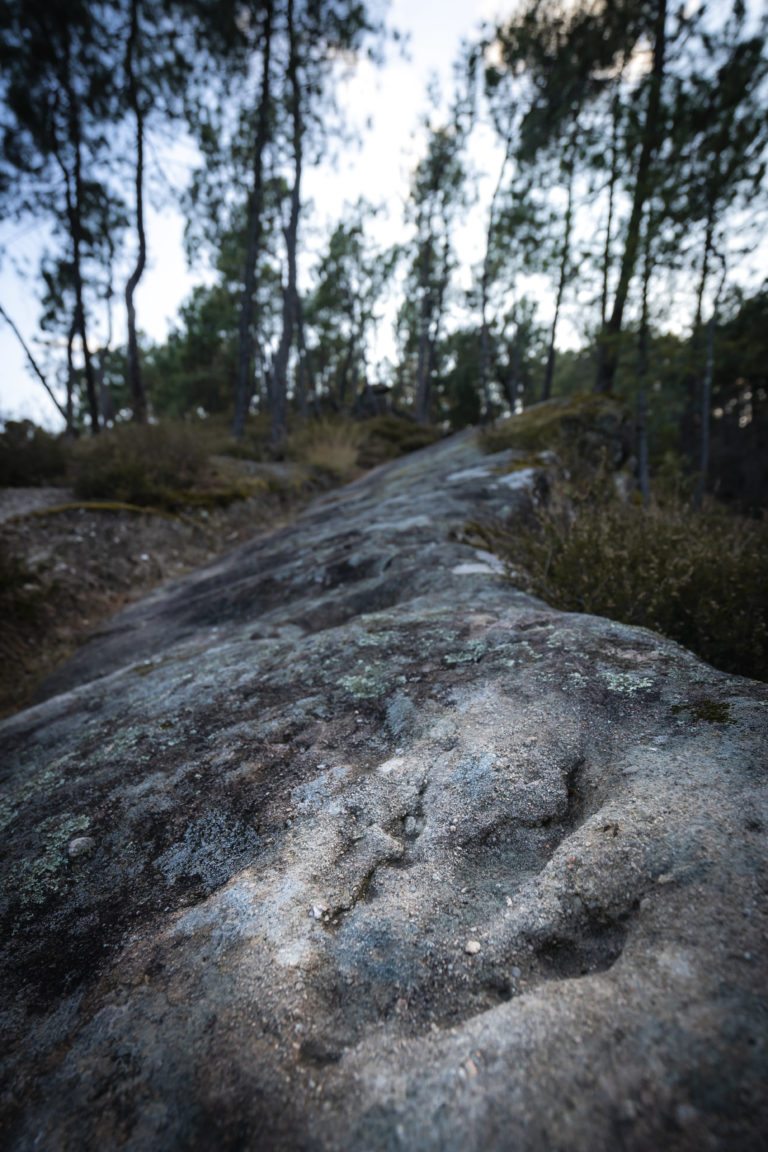Classification : The site aims to be subject to a Geotope protection order.
Managing Organization : Regional Natural Park of the Ardèche Monts
Presentation :
The main site is located north of Aubenas in the municipality of Ucel. It is a sandstone slab at the top of a small cliff facing ENE-WSW, on the western slope of the Ruisseau du Buis valley. The footprint area is approximately 50 m long and 2 to 4 m wide. The site geologically belongs to the upper part of the variegated formation, dated from around 216 Ma. For the main site, it is a sandstone slab which shows almost 200 footprints of large reptiles belonging to three different species. The outcrop is mainly made up of amalgamated and stacked sandstone channels.
The study of the rocks makes it possible to say that Le Sartre was at the time plains periodically flooded and crossed by many rivers which winded there. Large reptiles came to drink there. The climate was arid to subtropical. The footprint slab is now tilted to the south/southeast due to much more recent tectonic movements linked to the uplift of the Alps.
Fossils (remains of living things and traces of their activity) are generally preserved in fine sediments. The 300 footprints of Sartre are exceptional because they are preserved in medium to coarse sandstone (some sedimentary grains exceed 2 cm!). Indeed, the large terrestrial reptiles have walked (and sometimes slipped!) on a double layer of clay and silt positioned just above a level of coarse sand. The superimposition of these layers, with different properties, made it possible to record and preserve the movement of the animals. Later, the upper thin layers were eroded, leaving the imprints in the coarse sediments. We then speak of « underprints”.
Footprints with three fingers are by far the most common on the site. Their length is 10-15 cm on average. The mark of the claws is sometimes present. This type of fingerprint is attributed to the grallator. The authors of these footprints are bipedal theropod dinosaurs, resembling Coelophysis or Liliensternus. These carnivorous dinosaurs were 1 to 3 meters long and weighed about 20 to 40 kilos.
Large footprints often show the mark of four fingers (sometimes five). Called Otozoum (or Pseudotetrasauropus by some authors), these footprints were left by large prosauropod dinosaurs, such as Plateosaurus. These large dinosaurs were between 4 and 10 meters long and weighed around 1 to 4 tons.
Some footprints mark the support of the forelegs and hind legs of animals walking on 4 legs. These traces are attributed to Brachychirotherium. They were left by pseudosuchian reptiles who are close relatives of the current crocodiles. These footprints are very numerous in older Ardèche sites, but they are relatively rare on the Sartre site. Indeed, this remarkable site documents the decline of pseudosuchian faced with the growing domination of the first dinosaurs.
Scientific or educational interests :
The site presents an exceptional wealth and abundance of dinosauroid footprints for the Upper Triassic. It provides information on the evolution of large groups of reptiles in an interval characterized by major extinction in terrestrial ecosystems. It’s a perfect illustration of the evolutionary advent of dinosaurs.
With excellent quality of footprint preservation, this is an exceptional case of footprint preservation in sandstone to conglomerate levels.
Thematic keywords : conservation of collections, sedimentary geology, geomorphology, impact on tourist numbers, paleontology, palynology, 3D digitization topology, territorial sciences.
Keywords typology of sites : paleontological site, mediation space.
Access modalities :
Free access all year round. Upon request, possibility to access areas not open to the public.
Support possible : By a geologist from the Geopark Scientific Committee, by a member of the site research team if sufficiently anticipated.
